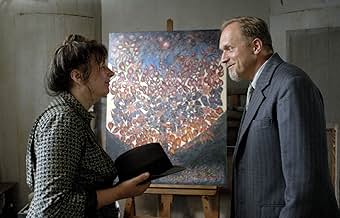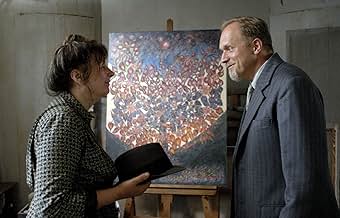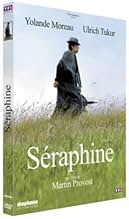VALUTAZIONE IMDb
7,4/10
6680
LA TUA VALUTAZIONE
Basato sulla vita della pittrice francese Séraphine de Senlis.Basato sulla vita della pittrice francese Séraphine de Senlis.Basato sulla vita della pittrice francese Séraphine de Senlis.
- Regia
- Sceneggiatura
- Star
- Premi
- 20 vittorie e 10 candidature totali
Léna Breban
- Soeur Marguerite
- (as Léna Bréban)
Sandrine Bodenes
- Marie-Louise
- (as Sandrine Bodènés)
Anne Benoît
- Madame Delonge
- (as Anne Benoit)
Recensioni in evidenza
I enjoy French films very much and saw Seraphine in Paris. While the movie looks beautiful and the acting is excellent, overall the film bored me. There wasn't enough dramatic tension or intense character development to sustain my interest. I was very surprised that it won so many awards, but then again if the French academy is similar to the one in the U.S., they tend to play it safe. Seraphine is worth seeing if you are interested in thinking about the artistic soul. But there is nothing groundbreaking here. I would have liked to see a version of this artist's life that was less academic and more thought provoking. The one thing I admired very much was the performance of the lead actress. I was trying to imagine anyone equivalent to her in the U.S. and was unable to conjure any names. She is not classically beautiful, yet clearly she is an actress of great stature in France to have won this role. The lesson I took away from the film was the appreciation of talent, both of Seraphine and the actress who portrayed her.
Séraphine was one of these so called common people who in the early 1900s were discovered. The expression "discovered" is not wrong, but that wasn't just about the person, it's was also about another type of seeing and another type of expression.
Séraphine lived a poor and humiliating life like most women of her class. Then this German art collector finds her. But it stops there, because for certain reasons he in the end can't improve her life materially. And the result is disastrous, because it means betrayal of a person, although not of her art.
A silent realistic movie, there you can smell the poverty and despair.
Séraphine lived a poor and humiliating life like most women of her class. Then this German art collector finds her. But it stops there, because for certain reasons he in the end can't improve her life materially. And the result is disastrous, because it means betrayal of a person, although not of her art.
A silent realistic movie, there you can smell the poverty and despair.
Séraphine de Senlis - born Séraphine Louis (1864- 1942) - may not be a painter well known to the entire art world today, but the story of her life makes a compelling film. Writer Marc Abdelnour and writer/director Martin Provost have extracted all of the significant aspects of Séraphine Louis' life and have created a work of art as a film, much in the style of the way she created her life in art.
Séraphine Louis (Yolande Moreau) was born in 1864 in Arcy to a poor family and worked as a shepherdess until 1881 when she accepted the position as a domestic worker for the Sisters of Providence in Clermont: her life with the nuns enhanced her profoundly religious approach to her personal philosophy. In 1901 she left the convent, in part due to a communication with her angel that she must paint, to become a housekeeper for middle class families in Senlis. In her quiet manner she scrubbed floors and did laundry by day, using the pittances of income to procure some supplies so that she could paint her images of fruits, flowers, and leaves by candlelight at night in her tiny room. Self taught, she used pigment from strange sources - blood from the butcher, melted wax from the votives at the cathedral, pollen from the flowers of the fields, her only 'purchased' component was gesso and white paint from the artist supply shop in Senlis.
In 1914 the German art collector and critic Wilhelm Uhde (Ulrich Tukur) took a room in the house owned by Mme Duphot (Geneviève Mnich), one of the houses where Séraphine worked, and when Wilhelm discovered a painting by Séraphine he immediately recognized a painter of great promise and provided Séraphine with the first response to her artistic efforts. Wilhelm and Séraphine became friends and Wilhelm bought all of her art, insisting that she devote her time to creating art instead of scrubbing floors. With the backing of a collector and friend, Séraphine began painting in earnest, showing locally and selling art under Wilhelm's sponsorship, until 1914 when with WW I breaking out, Wilhelm had to flee France, leaving behind his collection of paintings as well as the close bond the two had formed. Mistakenly Séraphine thought Wilhelm's departure was to marry his roommate Anne-Marie (Anne Bennett), only to discover that Anne-Marie was Wilhelm's sister and fellow supporter of Séraphine: Wilhelm informed her he would never be able to marry a woman.
Séraphine continued painting as she lead her eccentric life in Senlis and in 1927 Wilhelm returned to France with his paramour - young painter Helmut Kolle (Nico Rogner) who suffered from tuberculosis - rediscovers Séraphine's art in a local Senlis exhibition, and realizes that she had survived and her art had flourished. Under Wilhelm's patronage, Séraphine began painting large canvases as large as two meters high, and she achieved prominence as the naïve painter of her day. In 1929, Wilhelm organized an exhibition, 'Painters of the Sacred Heart', that featured Séraphine's art, launching her into a period of financial success she had never known - and was ill prepared to manage. Then, in 1930, with the effects of the Great Depression destroying the finances of her patrons, Wilhelm had no choice except to stop buying her paintings. Séraphine's spending habits cause concern and in 1932 her psychotic behavior resulted in placement in the psychiatric ward in Clermont hospital where she spent the rest of her days, alone and without friends or admirers of her gift of art.
The simplicity of the manner in which this story is related with very little dialogue, atmospheric scenery as captured by cinematographer Laurent Brunet, and a musical score by Michael Galasso that combines sacred chants with idiomatic instrumental music of French ancestry. Yolande Moreau glows with a special radiance as the simple, spiritual, artistically driven Séraphine and Ulrich Tukar is the perfect balance as his own driven, unique 'first true collector'. This film is a little masterpiece and one that deserves the attention of everyone who cares about the lives of artists and the emergence of genius from strange vessels.
Grady Harp
Séraphine Louis (Yolande Moreau) was born in 1864 in Arcy to a poor family and worked as a shepherdess until 1881 when she accepted the position as a domestic worker for the Sisters of Providence in Clermont: her life with the nuns enhanced her profoundly religious approach to her personal philosophy. In 1901 she left the convent, in part due to a communication with her angel that she must paint, to become a housekeeper for middle class families in Senlis. In her quiet manner she scrubbed floors and did laundry by day, using the pittances of income to procure some supplies so that she could paint her images of fruits, flowers, and leaves by candlelight at night in her tiny room. Self taught, she used pigment from strange sources - blood from the butcher, melted wax from the votives at the cathedral, pollen from the flowers of the fields, her only 'purchased' component was gesso and white paint from the artist supply shop in Senlis.
In 1914 the German art collector and critic Wilhelm Uhde (Ulrich Tukur) took a room in the house owned by Mme Duphot (Geneviève Mnich), one of the houses where Séraphine worked, and when Wilhelm discovered a painting by Séraphine he immediately recognized a painter of great promise and provided Séraphine with the first response to her artistic efforts. Wilhelm and Séraphine became friends and Wilhelm bought all of her art, insisting that she devote her time to creating art instead of scrubbing floors. With the backing of a collector and friend, Séraphine began painting in earnest, showing locally and selling art under Wilhelm's sponsorship, until 1914 when with WW I breaking out, Wilhelm had to flee France, leaving behind his collection of paintings as well as the close bond the two had formed. Mistakenly Séraphine thought Wilhelm's departure was to marry his roommate Anne-Marie (Anne Bennett), only to discover that Anne-Marie was Wilhelm's sister and fellow supporter of Séraphine: Wilhelm informed her he would never be able to marry a woman.
Séraphine continued painting as she lead her eccentric life in Senlis and in 1927 Wilhelm returned to France with his paramour - young painter Helmut Kolle (Nico Rogner) who suffered from tuberculosis - rediscovers Séraphine's art in a local Senlis exhibition, and realizes that she had survived and her art had flourished. Under Wilhelm's patronage, Séraphine began painting large canvases as large as two meters high, and she achieved prominence as the naïve painter of her day. In 1929, Wilhelm organized an exhibition, 'Painters of the Sacred Heart', that featured Séraphine's art, launching her into a period of financial success she had never known - and was ill prepared to manage. Then, in 1930, with the effects of the Great Depression destroying the finances of her patrons, Wilhelm had no choice except to stop buying her paintings. Séraphine's spending habits cause concern and in 1932 her psychotic behavior resulted in placement in the psychiatric ward in Clermont hospital where she spent the rest of her days, alone and without friends or admirers of her gift of art.
The simplicity of the manner in which this story is related with very little dialogue, atmospheric scenery as captured by cinematographer Laurent Brunet, and a musical score by Michael Galasso that combines sacred chants with idiomatic instrumental music of French ancestry. Yolande Moreau glows with a special radiance as the simple, spiritual, artistically driven Séraphine and Ulrich Tukar is the perfect balance as his own driven, unique 'first true collector'. This film is a little masterpiece and one that deserves the attention of everyone who cares about the lives of artists and the emergence of genius from strange vessels.
Grady Harp
An artist. Fragile, gray, small. Some dreams. A fall. And drops of hope. Few images. A mecena. In fact, story of an ordinary existence. Testimony of forms of beauty . Words of a warm confession, with a brilliant Yolande Moreau and an great director. Everything is in best place. Light and cast, details and looks. And the air of small persons , delicate gestures, definition of art and art as refuge are pieces of this movie. So, it is not a biographic film. Seraphines are many men and women, basic instruments for others who believes that life is more than lies and hypocrisy. Beginning for discover of reality without appearance, sad and beautiful, poem about shadows of a fight, word of a late fame, "Seraphine" must be see again and again. In every Senlis lives a Seraphine.
Seraphine Louis,who would eventually change her name to Seraphine deSenlis (after the name of her hometown)was an artist who cleaned houses by day,and painted by night (all the time while singing the hymns of her staunch Catholic upbringing,while she was growing up an orphan by Nuns). Seraphine is pretty much maligned by the village locals,taunted by children,and pretty much avoided by most all that know her. When German art collector & critic,Wilhelm Uhde rents a room in the town of Senlis,while on the run from the insanity of World War I,and discovers a painting by Seraphine & is amazed by it's use of colour & texture. When the war moves ever closer,Uhde & his sister escapes the madness. Years later,he returns to Senlis,rediscovers an aged,but still painting Seraphine & vows to put her work on display (despite the fallout of the Wall Street crash of 1929,as well as the subsequent great depression,that managed to cripple a good percentage of Europe's economy,as well). Martin Provost directs & co writes (with Marc Abdelnoir)a lovingly depicted portrait of a woman possessed of genius that is cruelly stolen too early (deSenlis spent her aged years in an insane asylum & never painted again in life). Yolande Moreau plays Seraphine,a woman unpossesed by pretentious,real fine. Ulrich Tukur plays Wilhelm Uhde,in a winning role that depicts Uhde as an impresario of art first,and who's personal life is down played,somewhat (in life,Uhde was an ardent homosexual that made no bones about his gay lifestyle). The photography is a real treat for the eye (at times,the composition of visual images are very painterly,such as films such as 'Tous Le Matin Du Monde'). A film to check out for those with a love of art,or art history (or both). Spoken in French & German with English subtitles. Not rated by the MPAA,this film contains flashes of nudity & adult content.
Lo sapevi?
- QuizSince the film's release, the number of visitors at the museum of Senlis exhibiting Séraphine's works has quadrupled (August 2009).
- BlooperThe film opens in 1914 showing the arrival of Wilhelm and Anne-Marie at the village. Wilhelm actually arrived in 1912, two years before the start of the war.
- Curiosità sui creditiThe credits list the names of the paintings which are seen in the film - 10 paintings by Séraphine and the artworks owned by Uhde and Kolle.
- Colonne sonoreConsonent laudes!
Written by Louis Rousseau
Performed by Yolande Moreau, Françoise Lebrun and Léna Breban
I più visti
Accedi per valutare e creare un elenco di titoli salvati per ottenere consigli personalizzati
- How long is Seraphine?Powered by Alexa
Dettagli
Botteghino
- Budget
- 3.674.000 € (previsto)
- Lordo Stati Uniti e Canada
- 884.613 USD
- Fine settimana di apertura Stati Uniti e Canada
- 38.637 USD
- 7 giu 2009
- Lordo in tutto il mondo
- 9.402.702 USD
- Tempo di esecuzione2 ore 5 minuti
- Colore
- Mix di suoni
- Proporzioni
- 1.85 : 1
Contribuisci a questa pagina
Suggerisci una modifica o aggiungi i contenuti mancanti



































